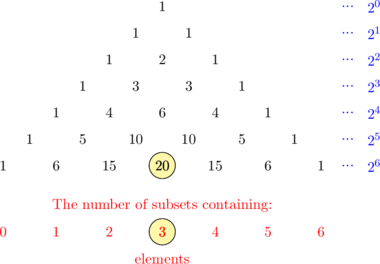Subset
\(\text{A}\) is a subset of \(\text{A}\) (\(\text{A}\subseteq \text{B}\)) if and only if every element of \(\text{A}\) is in \(\text{B}\)
\(\text{A}\) is a proper subset of \(\text{A}\) (\(\text{A} \subset \text{B}\)) if and only if every element in \(\text{A}\) is also in \(\text{B}\),
and there exists at least one element in \(\text{B}\) that is not in \(\text{A}\)
Example 1:
\(\text{A} = \lbrace 1, 2, 3 \rbrace\)
\(\text{B} = \lbrace 3, 1, 2 \rbrace\)
\(\text{A}\) is a subset of \(\text{A}\). (\(\text{A} \subseteq \text{B}\))
Example 2:
\(\text{P} = \lbrace 5, 10, 15, 20 \rbrace\)
\(\text{Q} = \lbrace 5, 10, 15, 20, 25, 30 \rbrace\)
\(\text{P}\) is a proper subset of \(\text{Q}\) because the element 25 and 30 is not in the set \(\text{P}\). (\(\text{P} \subset \text{Q}\))
The empty set is therefore a proper subset of any non empty set
Total Number of Subsets
The total number of subsets is the number of sets with 0 elements, 1 elements, 2 elements, etc
The total number of subsets of a set with n elements is \(2^{n}\)
Example 1:
From the set below, list all the subsets and find the total number of subsets
\(\text{Q} = \lbrace \text{a, b, c, d}\rbrace \)
Subsets of \(\text{Q}\) are:
\(\lbrace \rbrace,\:\:\lbrace \text{a}\rbrace, \:\: \lbrace \text{b}\rbrace, \:\: \lbrace \text{c}\rbrace, \:\: \lbrace \text{d}\rbrace\, \:\: \lbrace \text{a,b}\rbrace, \:\: \lbrace \text{a, c}\rbrace\)
\(\lbrace \text{a, d}\rbrace,\:\:\lbrace \text{b, c}\rbrace, \:\: \lbrace \text{b, d}\rbrace, \:\: \lbrace \text{c, d}\rbrace, \:\:\lbrace \text{a, b, c}\rbrace, \:\: \lbrace \text{a, b, d}\rbrace\, \:\: \lbrace \text{b, c ,d}\rbrace, \:\:\lbrace \text{a, c, d} \rbrace, \:\: \lbrace \text{a, b, c, d}\rbrace\)
Total number of subsets is \(2^n = 2^4 = 16\)
Example 2:
Find the number of subsets of \(\text{P} = \lbrace \text{a, b, c, d, e, f}\rbrace\) that contain exactly 3 elements
The total number of subsets of \(\text{P}\) is \(2^{6}\)
Using Pascal's triangle:

So, the number of subsets of \(\text{P}\) that contain exactly 3 elements is 20
Exercise
